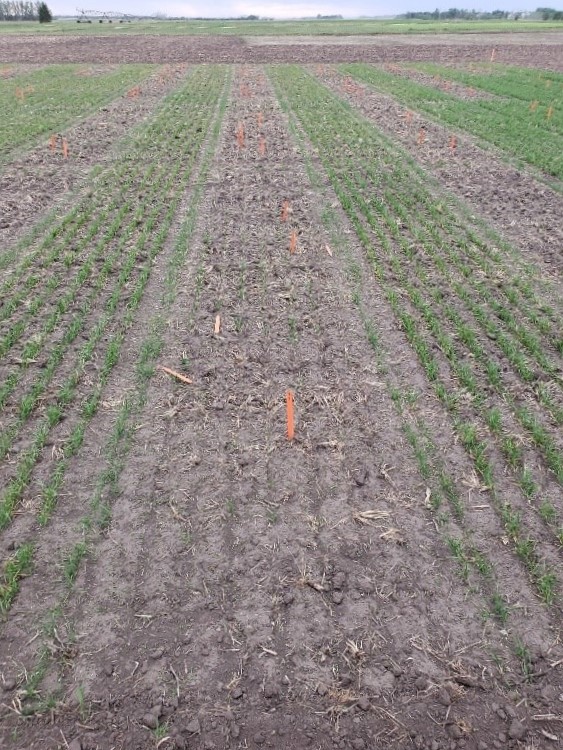Yield Impact of Seed-placed Nitrogen Fertilization of Wheat
Two field trials (dryland and irrigated) assessed spring wheat plant population, grain yields, and protein response to newly-developed experimental polymer-coated urea (PCU) fertilizers as slow release N fertilizers compared to ESN, an established slow release N fertilizer.
Trial 1: Irrigated wheat treatments
ESN, three experimental products (PCU1, PCU2, PCU3), urea seed-placed at 60 and 90 lbs/ac. Treatments included 90 lbs N as blend of 22 lbs urea N with 68 lbs N as ESN, PCU1, PCU2, PCU3. A control broadcast treatment was applied with Agrotain at 90 lbs N/ac.
Trial 1: Results
- Two weeks after seeding, plant population was significantly less for seed-placed N treatments with urea and the three PCUs. N rate had no impact on population or yields.
- Plant population was similar between Agrotain broadcast (42 plants/meter) and ESN treatment (38 plants on average), but was significantly greater than the other treatments (25 plants or less/meter).
- 22 lbs urea N caused significant population reduction in the urea/ESN blend.
- Average yield from ESN (69 bu/ac) was similar to Agrotain (63 bu/ac) but significantly greater than the other treatments (urea = 57 bu, PCU1 = 56 bu, PCU2 = 62 bu, PCU3 = 51 bu) and all blends.
- Urea caused yield loss when blended.
- Grain protein was similar for ESN (16.05%), Agrotain-broadcast (16.09%) and PCU1 (16.01%) treatments than PCU2 (15.50), PCU3 (15.56%) and urea (15.75%) seed-placed treatments.
- Even though grain yields for the PCUs and urea seed-placed treatments were less than for ESN and Agrotain treatments, yields were not significantly different, probably due to compensation from greater tiller numbers from relatively lower plant population during early growth (figure 1).
Trial 2: Dryland wheat treatments
ESN, PCU1, PCU2, PCU3, SuperU, urea seed-placed at 60 and 90 lbs/ac. Agrotain broadcast (as control) at 60 and 90 lb N. Soil N was 43 lbs/ac.
Results
- ESN seed-placed treatments had 24 plants each at 60 at 90 lbs N compared to the broadcast control Agrotain treatment with 37 and 33 plants, and zero plants for the other treatments.
- Yields were extremely low on dryland due to drought. Average yield was similar between Agrotain broadcast (14 bushels) and ESN (15 bushels) treatment. Yields were less than four bushels for all other treatments.
- Besides ESN and Agrotain treatments, yields were significantly reduced at 90 lbs compared to 60 lbs N.

Conclusions
Fertilizers are salts which can seriously impair seedling water absorption, resulting in desiccation. In addition, ammonia gas produced from the reaction of urea with water in soil be toxic to germinating seeds and seedlings. Damage is worse under dry conditions, with high soil pH, and in lighter (sandy) soils. The lower impact of seed-placed N fertilizer and different N rates under irrigation was due to higher soil moisture. ESN was the only slow release N fertilizer that showed no negative impact when applied with seeds, even at 90 lbs N. Yield loss can be expected when urea is blended at 22 lbs N with ESN.
Jasper Teboh, Ph. D.
Jasper.Teboh@ndsu.edu
Soil Scientist
